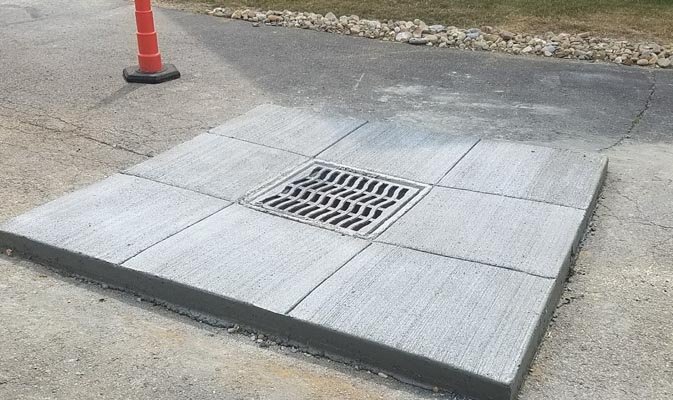Catch Basins
Catch Basins: Strategic Placement and Essential Reasons for Installation
Catch basins play a pivotal role in modern stormwater management. As underground structures equipped with grates, they are designed to collect and divert water runoff, simultaneously preventing larger debris from clogging the drainage system. But where is the ideal location for these basins, and why are they indispensable for urban areas and landscapes alike? Here's an exploration.
Optimal Locations for Catch Basin Installation:
Parking Lots
Parking areas, especially vast ones like those in commercial complexes, can gather significant rainwater. Installing catch basins ensures swift water removal, mitigating puddle formation.
Street Intersections
These are areas of convergence for water flow, especially in urban setups. Placing catch basins here ensures swift water capture before it becomes a roadway hazard.
Driveways
Particularly in sloped driveways, water may accumulate or flow towards the home. A catch basin can help direct this water away from the property.
Building Downspouts
By placing catch basins near downspouts, you can prevent water accumulation and guide it away from the building's foundation.
Recreational Parks
Parks often have undulating terrains and paved pathways. Installing catch basins at strategic points ensures that play areas, walking paths, and other zones remain usable after rainfall.
Gardens & Landscapes
In landscaped areas, catch basins can help manage water, preventing erosion and damage to plants due to overwatering.
Sporting Areas
Be it golf courses or football fields, sports arenas need efficient water management. Catch basins ensure that these areas aren't bogged down after a rain.
Pedestrian Walkways
Especially in urban areas, walkways can flood quickly. Catch basins keep these pathways dry and safe.
Fundamental Reasons for Installing Catch Basins
Flood Prevention
The primary role of a catch basin is to collect stormwater rapidly, preventing flooding on streets, driveways, and other areas.
Protection of Infrastructure
Continuous water accumulation can damage roads, driveways, and building foundations. By redirecting water, catch basins help in maintaining the integrity of these infrastructures.
Safety Assurance
Wet and flooded areas become slipping hazards. Proper drainage ensures pedestrian safety.
Preventing Water Damage
For structures, excess water can be a menace, leading to mold growth, foundation damage, and more. Catch basins divert this water, protecting buildings and landscapes.
Aesthetics
Waterlogging can ruin the visual appeal of recreational parks, gardens, and other public spaces. Efficient drainage maintains the aesthetic value of these areas.
Environmental Protection
By trapping larger debris and pollutants, catch basins play a role in preventing these contaminants from directly entering water bodies.
Maintenance of Ecosystem
Proper drainage ensures that water doesn't inundate areas, which could harm plants, insects, and micro-ecosystems in gardens and parks.
Value Addition
Well-drained properties, especially those that manage stormwater efficiently, can be more appealing to potential buyers, adding value to the property.
Flexibility
Catch basins can be connected to various drainage solutions like storm sewers, rain gardens, or detention ponds, making them versatile in addressing diverse drainage needs.
Catch basins serve as frontline guardians against the challenges posed by stormwater in urban and landscaped environments. Their strategic placement can make the difference between a well-drained, functional space and one that's susceptible to flooding and water damage. Investing in quality catch basins and ensuring their proper installation is paramount for modern infrastructure, aesthetics, and environmental considerations. As urbanization continues its pace, the role of catch basins in managing water becomes ever more critical, proving their worth time and again.
Catch Basin questions and Answers
What is a catch basin?
A catch basin is an underground drainage structure designed to collect and divert stormwater runoff. It has a grate on top and a sump at the bottom to capture larger debris and prevent it from entering the drainage system.
How does a catch basin work?
Water flows over the surface and enters the catch basin through its grate. The heavier sediment and debris settle at the basin's bottom, while the cleaner water flows out through an outlet pipe to a storm sewer or other drainage solution.
Why is a catch basin important?
Catch basins prevent flooding by efficiently collecting stormwater. They also help in preventing larger debris and contaminants from clogging the drainage system or entering natural water bodies.
How often should catch basins be cleaned?
It's advisable to inspect catch basins at least twice a year, preferably before the rainy seasons. Cleaning frequency depends on debris accumulation but typically once a year or when about one-third of the basin fills with sediment.
Where should catch basins be installed?
Catch basins are ideally placed in low points or areas of water convergence, such as parking lots, street intersections, driveways, downspouts, parks, and pedestrian pathways.
Are catch basins and storm drains the same?
While they are related, they're not the same. A catch basin collects water and debris, allowing sediment to settle. A storm drain, on the other hand, is a system of underground pipes that carries the filtered water from catch basins to local water bodies.
Can catch basins become mosquito breeding grounds?
Stagnant water in catch basins can attract mosquitoes. Regular cleaning and ensuring proper water flow can mitigate this issue.
What materials are catch basins made of?
Catch basins can be made from various materials, including concrete, plastic, and metal. The choice often depends on the application, local regulations, and budget.
How deep is a catch basin?
The depth varies based on design and purpose. Residential catch basins might be 1-2 feet deep, while those in commercial or municipal settings could be deeper. Depth also accommodates the sump area for sediment collection.
How much does catch basin installation cost?
Costs vary based on size, material, location, and installation complexity. It's best to get quotes from local contractors or drainage professionals to get an accurate estimate for specific needs.

